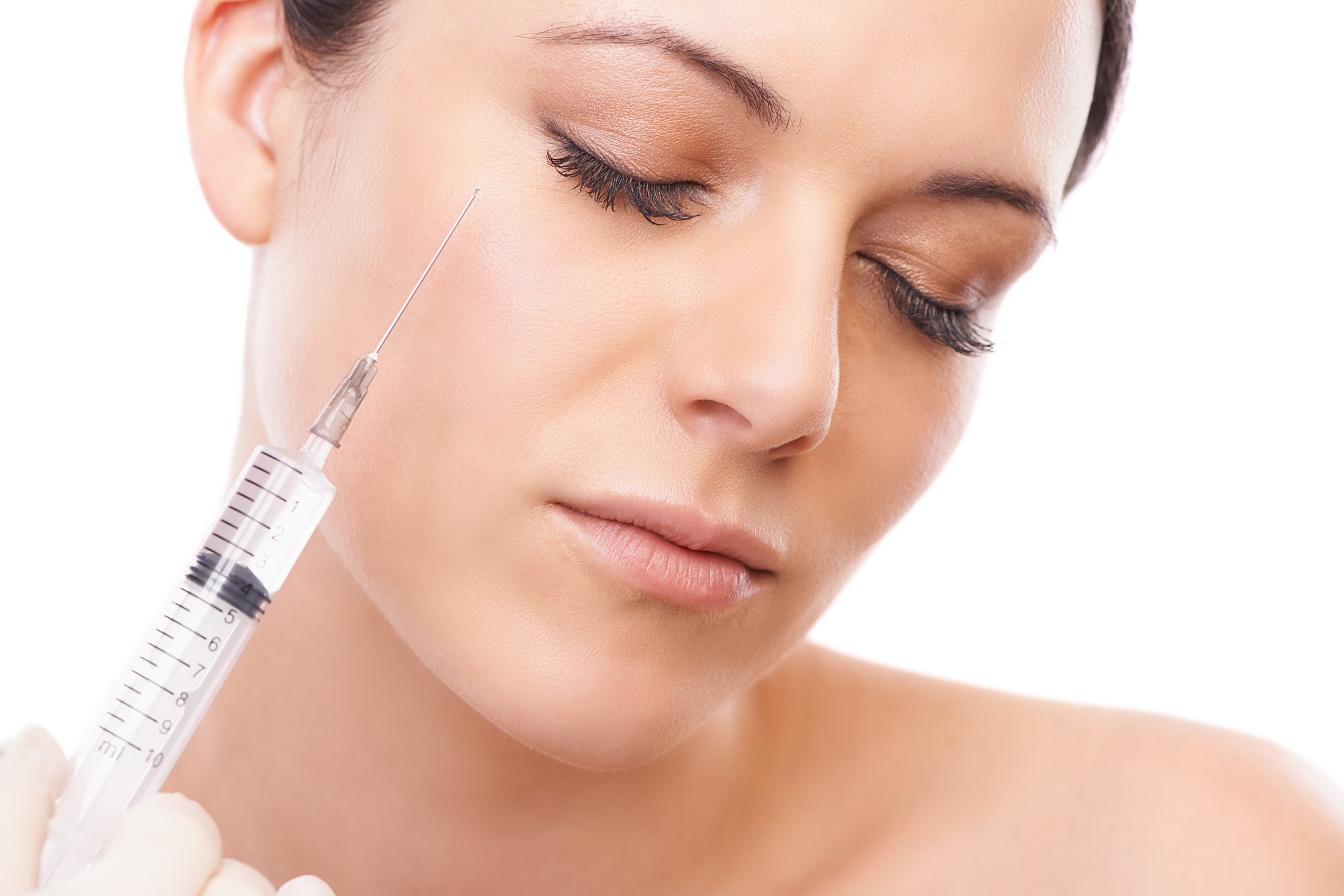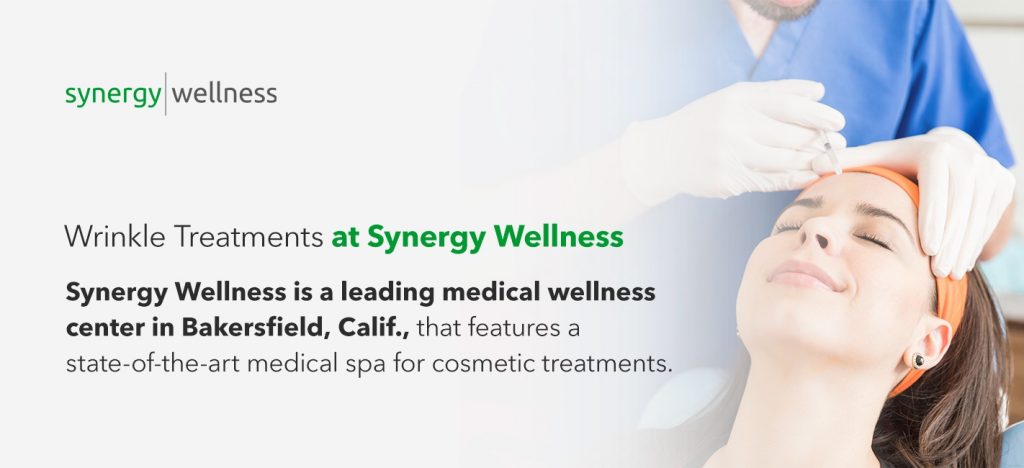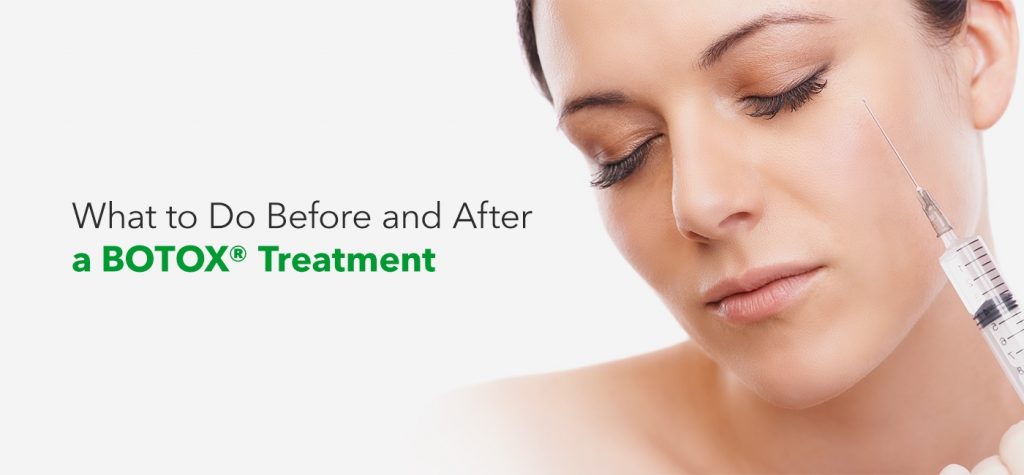
Common signs of facial aging include wrinkles, creases and lines. While these are typical aspects of the aging process, many people may feel self-conscious about looking older. BOTOX® is a popular treatment for patients looking to soften facial wrinkles and other signs of aging.
BOTOX® is one of the most popular non-surgical cosmetic treatments that doesn’t require anesthesia or a lengthy recovery period. Physicians can place BOTOX® injections into specific muscles to precisely target the cause of wrinkles. BOTOX® Cosmetic is an FDA-approved treatment to temporarily improve the appearance of moderate to severe facial lines and wrinkles.
Contact Us for Wrinkle Relaxer Treatments
What Is BOTOX®?
BOTOX® is a neurotransmitter derived from a highly purified version of botulinum toxin. A BOTOX® treatment can improve the appearance of facial wrinkles, creases and folds. While BOTOX® is a versatile product, it has received FDA approval to treat wrinkles in the upper third of the face. BOTOX® works by blocking the nerve signals that cause muscle contractions, softening the facial features and reducing the severity of wrinkles.
One of the most effective uses for BOTOX® Cosmetic is to treat forehead wrinkles and frown lines. Additionally, many physicians also use BOTOX® injections to soften eye wrinkles, such as crow’s feet. Most BOTOX® appointments only take a few minutes, but the overall time will depend on the size of your treatment areas and the degree of aging you’re experiencing. Because BOTOX® is a non-surgical treatment, most patients can return to work or daily activities almost immediately.
How to Prep for a BOTOX® Appointment
It’s always best to understand what to expect before getting BOTOX® injections. When preparing to get their first BOTOX® treatment, patients should ensure that they provide their physician with all the essential information they might need.
While a BOTOX® treatment is relatively brief and straightforward, especially compared to traditional plastic surgery procedures, patients should still educate themselves to understand the process. After doing a bit of homework, you can learn more about the treatment and compile any relevant questions you may have for your provider. These seven tips on what to know before getting BOTOX® can help you get ready for your appointment.
1. Do Your Research
Before considering any cosmetic treatment, it is always best to learn as much as possible about the topic. Researching BOTOX® can help you understand if it may be right for you. Additionally, reading up on BOTOX® allows you to think of any potential questions you may want to ask your physician.
As with any procedure, you should also understand the potential risks. While BOTOX® is a very safe product with medical and aesthetic purposes, every treatment carries some level of risk. Learning about BOTOX® can also help you discover its various benefits and uses.
2. Book a Consultation
An initial consultation can help you learn more about BOTOX® and whether it is right for you. During a consultation, you should make sure to share any allergies, illnesses or health conditions you may have, which can help a physician determine if you are a good candidate for BOTOX® injections.
A first-time consultation can also ensure you and your provider are compatible. During this appointment, you can ask to see before-and-after photos from previous patients. Result pictures can help you gain a better understanding of their work and what to expect.
3. Avoid Blood Thinners
You may need to stop taking specific medications before getting BOTOX® injections, including muscle relaxants, allergy medications and blood thinners. We generally recommend patients stop taking these medications at least one to two weeks before their appointment.
If you rely on daily medications, it is best to let your physician know so they can plan appropriately. Blood thinners may increase your risk of bruising after BOTOX® injections. Additionally, patients should also avoid any drugs with blood-thinning properties, including aspirin.
4. Clean Your Face
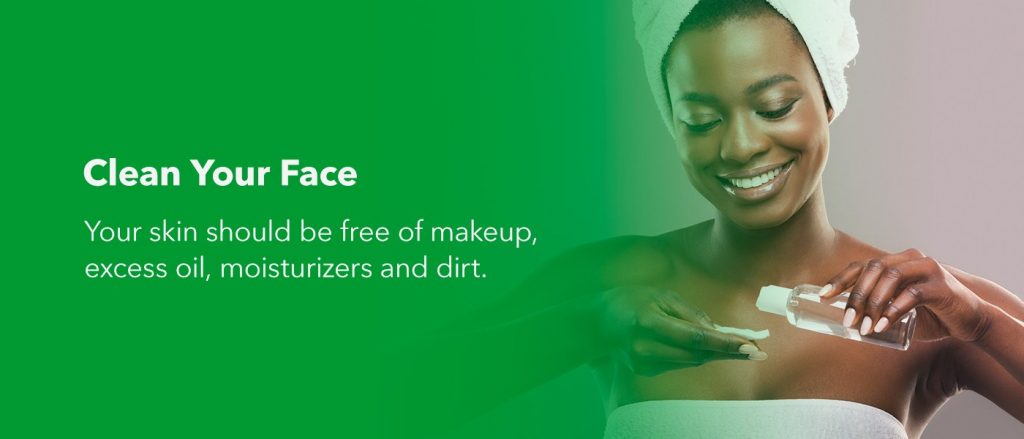
To prep for BOTOX® injections, you should ensure your face is clean beforehand. Your skin should be free of makeup, excess oil, moisturizers and dirt. Use a mild cleanser and water to wash your face, then gently pat it dry with a towel. Before your BOTOX® injection, your injector will sanitize the treatment area with an antiseptic wipe and rubbing alcohol.
5. Consider Icing the Area
Icing your treatment area before your BOTOX® appointment may help reduce the amount and severity of bruising you may experience. Before your treatment, you can wrap an ice pack in a towel and apply it to the treatment area for at least 20 minutes.
Some physicians even recommend icing the treatment area the day before your appointment. If you don’t have an ice pack, you can apply a bag of ice to your face as well. You can also request an ice pack leading up to your appointment as you wait for your provider.
6. Try to Relax
If it’s your first time getting BOTOX® injections, you may feel a bit nervous before your appointment. Remember that BOTOX® is a very safe and minimally invasive treatment that causes little discomfort when administered.
If you feel anxious leading up to your treatment, make sure to talk to your physician and let them know. An experienced injector can help put your nerves to rest by explaining the procedure in more detail and helping you understand the benefits and goals of your treatment.
7. Set Realistic Expectations
When undergoing any cosmetic treatment, you should go in with realistic expectations. While result photos from previous patients are an excellent way to learn more about your provider’s skill, the goal of aesthetic medicine isn’t to make you look like a different person.
While BOTOX® is one of the most popular wrinkle treatments, remember that everyone is unique and will experience different results. BOTOX® can help improve wrinkles and signs of aging, but not eliminate them permanently. BOTOX® provides temporary results that will require additional follow-up appointments to maintain.
What to Avoid After a BOTOX® Appointment
On average, 1 million Americans get BOTOX® a year. Following BOTOX® injections, it is typical to experience slight sensitivity or redness at the injection site and general treatment area. After your treatment, your physician will prepare you for what to expect. Following all recommendations from your provider will minimize your risk of potential complications. These seven tips on what to expect after getting BOTOX® can help you prepare for your treatment.
1. Touching the Injection Site
Following a BOTOX® treatment, you should avoid touching your treatment area and injection sites. Rubbing your face and applying pressure to the injection sites can cause the BOTOX® to migrate to other areas of your face, which can lead to complications, including a droopy eye or unexpected swelling.
Keeping your hands off your treatment area can help minimize your risk for potential complications. Most injectors recommend not touching your face for at least 24 hours following your appointment. Be sure to ask your provider when you can touch your face or apply pressure again.
2. Leaning or Lying Down
For several hours after your BOTOX® treatment, you should avoid leaning, bending over or lying down. By remaining upright, you can prevent BOTOX® from traveling to other areas of your face and avoid potential complications that migrating BOTOX® may cause.
Generally, it is best not to lie down for at least four hours after a BOTOX® treatment, but this time may vary from patient to patient. You may need to wait longer if you received a larger amount of BOTOX® or had several areas treated. Staying upright for at least four hours allows BOTOX® to target the muscles more effectively.
3. Exercising

After BOTOX®, you can exercise after at least four hours of rest. However, we usually suggest waiting 24 hours before a workout or strenuous activity. It is crucial to follow your physician’s advice when determining how long after BOTOX® you can exercise.
The amount of time you need to wait before exercising after BOTOX® will depend on numerous factors, including the size of your treatment area and how many units of BOTOX® you received. Exercise increases blood flow to the muscles, which can diffuse or migrate BOTOX®.
4. Blood Thinners
It is essential to avoid blood thinners for a period after your BOTOX® treatment. Blood thinners and medications with blood-thinning properties, including aspirin, can increase your risk of bruising after BOTOX®. These medications can also cause excessive bleeding after a BOTOX® treatment.
During a BOTOX® consultation, you should let your physician know about any over-the-counter or prescription medication you take regularly. Your injector can help you determine if you need to stop taking these medications before or after treatment. In addition to aspirin, your provider may also recommend that you do not take ibuprofen or Excedrin.
5. Smoking
Smoking after BOTOX® can shorten the longevity of your results following treatment. If you choose to have BOTOX® to improve perioral wrinkles, your results might not last as long as someone who doesn’t smoke. Many patients experience better and longer-lasting anti-aging results if they do not smoke.
If you choose to continue smoking after BOTOX® injections, you may notice your results fade more quickly. Smoking can negate a BOTOX® treatment’s benefits. Since the chemicals in cigarette smoke can cause premature aging of facial skin, among other health issues, many patients choose to stop smoking after a BOTOX® treatment.
6. Drinking
Alcohol will also thin your blood, which can cause complications after a BOTOX® treatment. As with blood-thinning medication, it is generally best to avoid consuming alcohol before or after a BOTOX® appointment.
If you drink alcohol after a BOTOX® treatment, you may be at a higher risk of bruising. Patients who drink alcohol immediately before or after BOTOX® injections may also be more vulnerable to experiencing excessive bleeding at the injection site. In most cases, physicians recommend waiting 24 hours before consuming alcohol again.
7. Facial Treatments
You should avoid getting facial treatments or massages immediately after your appointment. Facial massages can disrupt BOTOX® and cause it to migrate to different muscles or areas of the face. It is best to avoid any pressure on your face and any form of facial massage for at least four hours after your treatment.
Many facial treatments use harsh chemicals or formulas that can interfere with BOTOX® injections. Patients should avoid facials, masks and chemical peels for at least one week following a BOTOX® treatment. Receiving a facial or massage before then may increase your risk of complications. If you are looking to plan a facial treatment, make sure to ask how long you should wait after your appointment.
How Long Do BOTOX® Treatments Last?
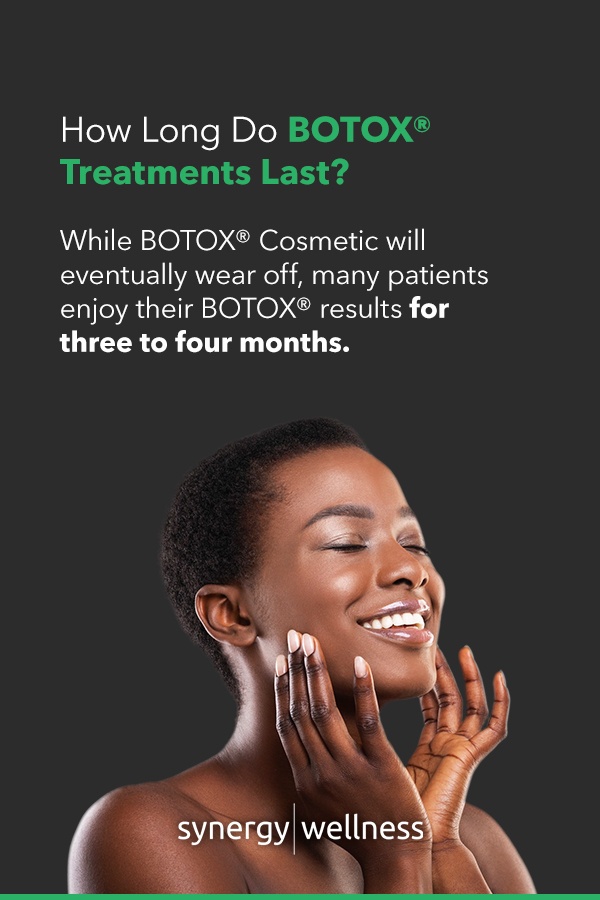
BOTOX® is an effective treatment that can soften the severity of facial wrinkles, lines and folds. While BOTOX® Cosmetic will eventually wear off, many patients enjoy their BOTOX® results for three to four months. Some behavioral or lifestyle choices may shorten the longevity of BOTOX® injections, including excessive sun exposure, alcohol use or smoking.
Your doctor can help you determine when to get BOTOX® and when you may need a follow-up appointment. Your touch-up treatment date can be flexible if you notice results fading sooner or even lasting longer than originally expected.
Is BOTOX® Right for You?
BOTOX® is a versatile wrinkle treatment that can improve fine lines, creases and more. While many may think BOTOX® is only popular among celebrities, a BOTOX® treatment is a great way to improve signs of facial aging for anyone. Additionally, wrinkle relaxers for men are a popular treatment for men looking to treat facial wrinkles or creasing. A consultation with your physician can help you determine if you may be an ideal candidate for BOTOX® injections.
When to Get BOTOX®
BOTOX® timing will vary from person to person, but many physicians generally recommend getting BOTOX® when the appearance of fine lines, wrinkles and other signs of facial aging become more apparent and start to make you feel self-conscious. In many cases, people may begin to develop wrinkles or creases in their 30s, which may be an ideal time to start considering BOTOX® treatments.
Wrinkle Treatments at Synergy Wellness
Synergy Wellness is a leading medical wellness center in Bakersfield, Calif., that features a state-of-the-art medical spa for cosmetic treatments. Our team of experts provides innovative and natural-looking procedures to reduce the signs of aging and improve our patients’ confidence. We are a well-established provider of wrinkle relaxer treatments and other innovative procedures to rejuvenate your appearance.
To learn more about wrinkle relaxer treatments, call 661-878-9100 or contact us online today.


